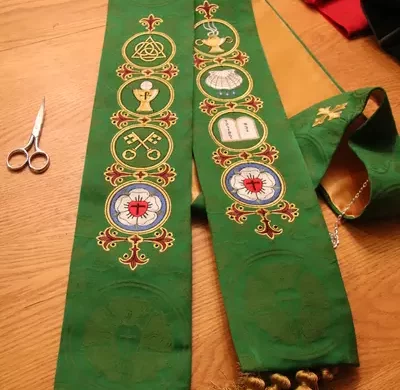
We enter a season filled with green trees and grass dotted with bright pink, purple, red, and white the flowers blooming profusely all around us. One glance around nature provides a feast of green shades for the eye to behold. It brings the entire world to life. Green is also the color for ordinary times in the church years. With the long Trinity Season or the “Green” Season just getting underway in the church year.
Like this:
Like Loading...
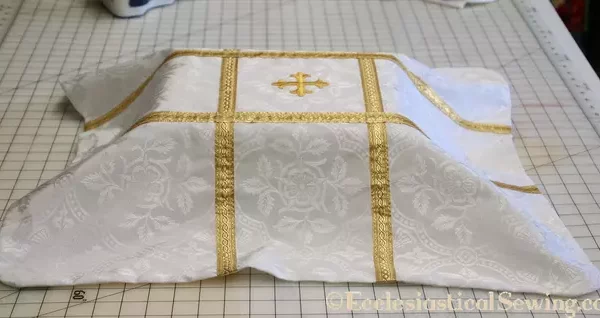
The tradition within the church is to use a Pall to cover the coffin for funerals. At the time of Pugin (early to mid-1800s), Palls were elaborate items, often embellished with extensive embroidery and gold work. Palls are still used today to cover a coffin during a funeral service. They are frequently white in color with a cross or other appropriate design applied. While churches may own a Pall for covering a coffin, they may not have a pall for covering an urn. The use of urns to replace large coffins is becoming more common.
Like this:
Like Loading...
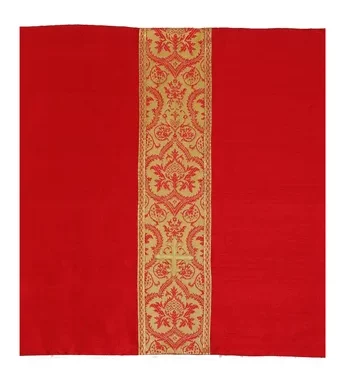
To test a pattern for a Chalice Veil at Ecclesiastical Sewing, red silk dupioni was used for the face fabric, satin for the lining, and Evesham brocade for the orphrey band, trimmed with Saint Benet trim. The process involved measuring, cutting, and adding the orphrey band and trim. Basting the trim before sewing helped ensure it stayed straight. After completing the orphrey band, it was stitched to the silk, a cross was applied with an iron, and the lining was hand-stitched. The final result is a beautiful Chalice Veil in the Saint Gregory Collection of Vestments.
Like this:
Like Loading...
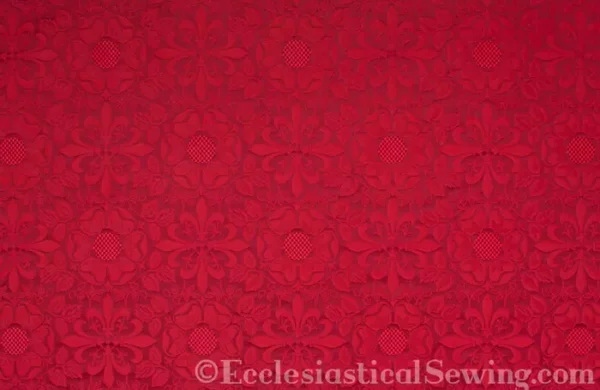
Evesham, which is made from silk fibers, comes in two different pattern scales: a large size pattern, and a small pattern. With two sizes of scales of patterns to select from, The project will combine the use of both the large and small patterns of Evesham.
Like this:
Like Loading...

The liturgical vestment known as the stole–the type we see today–came into form around the twelfth century; it has retained the basic shape familiar to us with minor variations over time. The variations include width, spade ends, and neckline variations. The styles of stole decorations have changed dramatically through the centuries.
Like this:
Like Loading...

Reversible Wakefield is a stunning Metallic Ecclesiastical Fabric – a brocatelle. This liturgical fabric features an elaborately textured weave that adds depth and dimension to the design details.
Like this:
Like Loading...
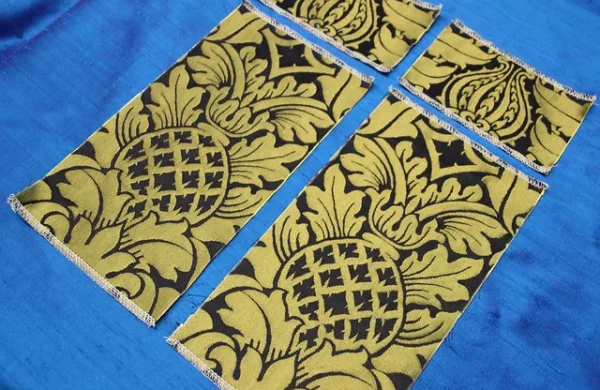
The St. Benet Black/gold trim is an excellent choice for either colored stole, as is the Black Dice trim, or the Gold St. Paul Braid.
Like this:
Like Loading...
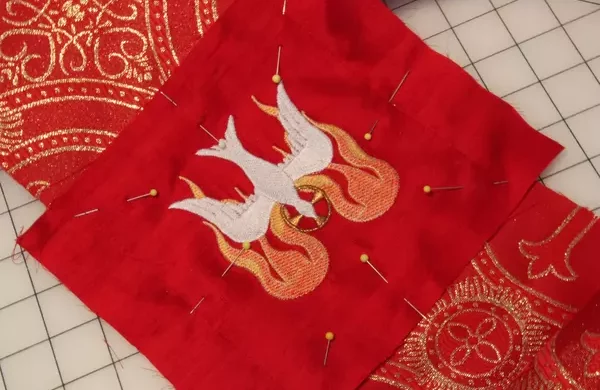
Pentecost Stoles. The first design features crossed keys symbolizing the Office of the Keys. The red silk dupioni, design with gold and bronze metallic threads, blends beautifully with red and gold brocatelle fabric and metallic galloon trim. The upper chest will showcase a descending dove with flames. and the final design will include a Bible and Sword of the Spirit, connecting to the Holy Spirit. These red Pentecost Stoles offer a reasonable budget.
Like this:
Like Loading...
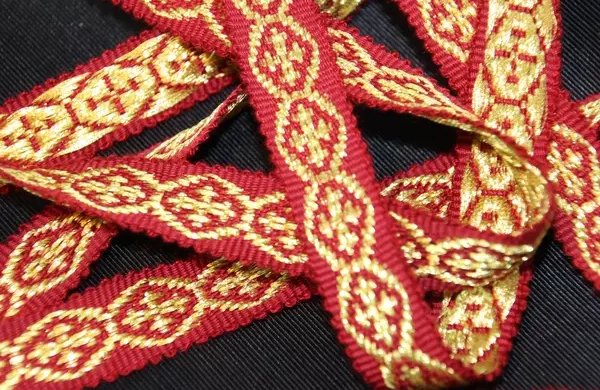
Dice Trim,” has tiny alternating squares woven in a solid color and a gold thread. This trim, although narrow at 1/2″, is a powerhouse of a trim, it gives a clean, tailored look. It sews very nicely. It comes in a nice assortment of liturgical colors: black, red, green, blue, gold, white, and purple. Dice Braid offers a very clean, tailored, crisp finish to vestments. It can be used to edge the long sides of stoles or as an end finish to a stole. It can be used as a finish on the edge of a chalice veil, as well as being used on any other type of vestment where trim is needed.
Like this:
Like Loading...
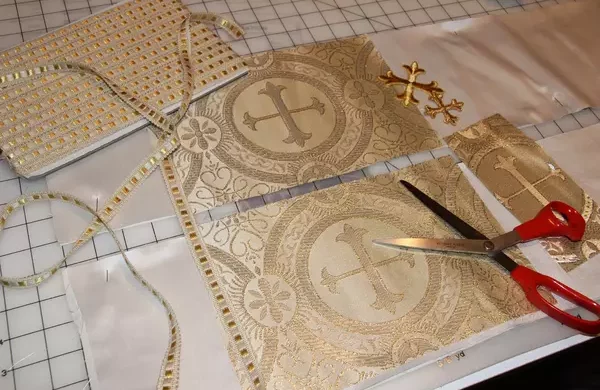
The white base fabric and fabric for orphrey trims. Finishing trim: galloon trim, braid, fringe, tassels and other trims suitable for Church vestments
Like this:
Like Loading...
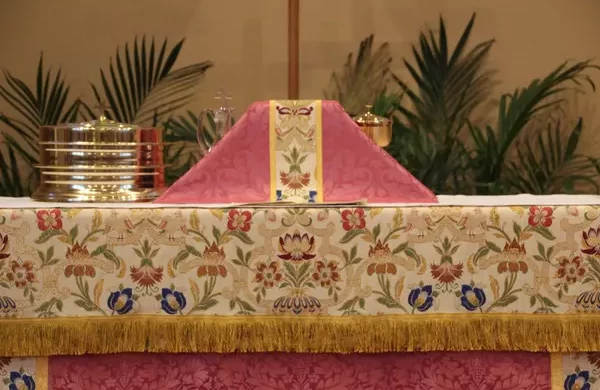
Chalice veils are very simple to construct. The beauty of the finished piece lies in excellent workmanship construction techniques and appropriate design placement. The design of a chalice veil can be as simple or elaborate as the imagination allows. Although the chalice veils do not have any trim around the edge, it is appropriate to use a cord as a decorative finish at the seam. Chalice veils often have a cross motif placed on the front edge too.
Like this:
Like Loading...
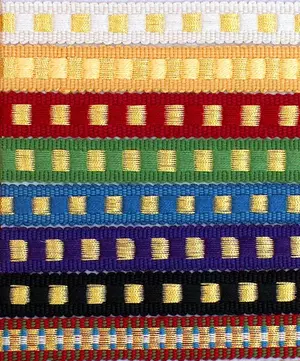
Sharing a vintage church embroidery design from the 1800s, still in the “rough draft” phase and the possibilities for church embroidery design are endless. On option is this versatile design could be used for whitework on altar linens or adapted for silk and gold threads on stole ends or maniples. Placing it in a quatrefoil frame makes it suitable for chasubles or burses. Stretching and elongating for a double oval ring offers options for stoles or chasubles. The design, enhanced with Dice Trim, can also adorn chasubles and dalmatics. The journey of creating ecclesiastical designs is ongoing, offering endless opportunities to learn and explore.
Like this:
Like Loading...













You must be logged in to post a comment.